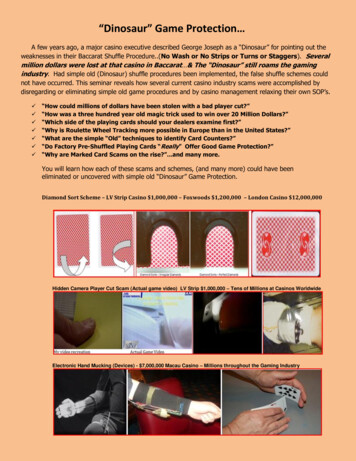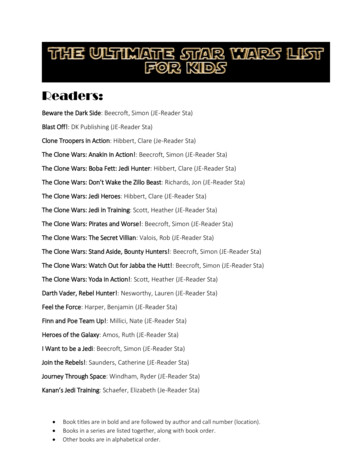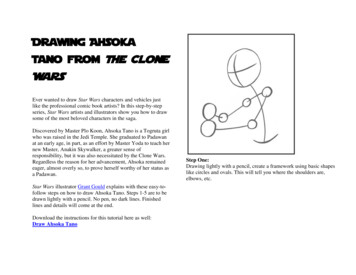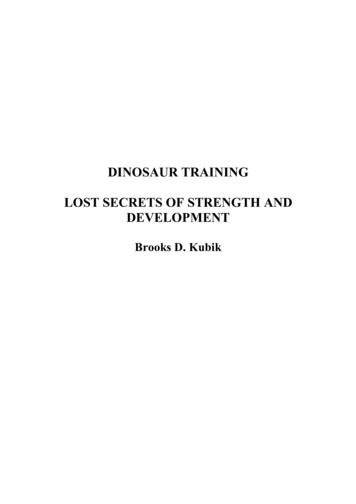
Transcription
Page 1Dinosaur WarsProgram TranscriptNarrator: For more than a century, Americans have had a love affair with dinosaurs. Extinctfor millions of years, they were barely known until giant, fossil bones were discovered in themid-nineteenth century.Two American scientists, Edward Drinker Cope and Othniel Charles Marsh, led the way tomany of these discoveries, at the forefront of the young field of paleontology.Jacques Gauthier, Paleontologist: Every iconic dinosaur every kid grows up with,apatosaurus, triceratops, stegosaurus, allosaurus, these guys went out into the AmericanWest and they found that stuff.Narrator: Cope and Marsh shed light on the deep past in a way no one had ever been able todo before. They unearthed more than 130 dinosaur species and some of the first fossilevidence supporting Darwin’s new theory of evolution.Mark Jaffe, Writer: Unfortunately there was a more sordid element, too, which was theirinsatiable hatred for each other, which often just baffled and exasperated everyone aroundthem.Peter Dodson, Paleontologist: They began life as friends. Then things unraveled andunraveled in quite a spectacular way.Narrator: Cope and Marsh locked horns for decades, in one of the most bitter scientificrivalries in American history. Constantly vying for leadership in their young field, theycompeted ruthlessly to secure gigantic bones in the American West. They put Americanscience on the world stage and nearly destroyed one another in the process.
Page 2In the summer of 1868, a small group of scientists boarded a Union Pacific train for asightseeing excursion through the heart of the newly-opened American West.Among them was O.C. Marsh of Yale, America’s first university professor of paleontology.Looking out the window, Marsh was transfixed. While his fellow passengers saw magnificentlandscapes, Marsh saw much more.Schooled in geology, he knew that great troves of prehistoric fossils could be buried in theancient rocks. "I felt that entombed in the sandy clays," he recalled, " there must be hiddenthe remains of many strange animals new to science, long waiting to be brought to life." Herewas a chance to establish his reputation while working on the greatest scientific problem ofthe age.Charles Darwin’s revolutionary work, On the Origin of Species, had been published in Englandonly a few years earlier. But Darwin despaired that little physical evidence of evolution couldbe found in Europe, where the heavily forested land concealed the geology underneath. Thearid, open American West, Marsh was convinced, would yield the kind of fossil evidenceneeded to prove Darwin’s theory.Bob Bakker, Paleontologist: The American West is blessed by a couple of things. Numberone, a long history of mountains going up. When mountains go up the, next to the foothills ofthe mountains are a depression, a basin. And as soon as mountains go up they start gettingeroded by streams. The streams bring down sand and mud that fills up that basin at thebottom of the foothills.That’s a wonderful place to die and leave a good-looking corpse. But wait! There’s anotherelement. It’s dry! It’s really dry. It’s drier than the Alps or the Urals. It’s drier than theCaucuses. So when you could take the railroad to Wyoming, Colorado and New Mexico, you
Page 3walk around, you’ll see the rocks, naked rocks. And the rocks are full of fossils, includingbones.Narrator: Marsh collected little on this first trip, but like a prospector who’d just caught aglimpse of the mother lode, he vowed to return. Next time he’d bring a work party, preparedto hunt for bones in the richest fossil fields on earth.O.C. Marsh was not the only one thinking about the deep past in 1868. In Philadelphia, at theAcademy of Natural Sciences, the world’s first mounted dinosaur skeleton went on display. Itwas called hadrosaurus - a creature said to have gone extinct millions of years ago, and sounlike anything in the modern world, it challenged the biblical story of creation.Now, barely three years after the end of the Civil War, it seemed that everything in America,even the story of the prehistoric past, was up for grabs.Steven Conn, Historian: Americans in the middle of the 19th century experienced tworevolutions simultaneously. One, of course, is the Civil War, and that changes everythingabout the country politically, economically, socially. And the other is scientific.The idea that the world hasn't always been like it is today, in fact, where we might bestanding right now was completely different ten million, 100 million, 400 million years ago, isa really powerful, fascinating, thrilling idea for people.Narrator: The hadrosaur had been unearthed in a quarry in Haddonfield, New Jersey, andassembled by a group of scientists that included a 28-year-old Philadelphia Quaker.Edward Drinker Cope had already made a name for himself with the discovery of the secondknown American dinosaur skeleton, a creature he named Laelaps. A self-taught prodigy, he’dbeen captivated by science since childhood.
Page 4Peter Dodson, Paleontologist: Cope took a great interest in natural history. And at a veryyoung age, he gained admission to the Academy of Natural Sciences, which was not open tothe public in those days. And he would make drawings of Ichthyosaurus and Plesiosaurs fromthe time that he was nine years old. He was a brilliant fellow.Narrator: Cope haunted the Academy through his teens, learning anatomy, organizingcollections of fish and snakes, developing a passion for fossils.Like his mentor Joseph Leidy, the discoverer of hadrosaurus and America’s firstpaleontologist, Cope was a gentleman naturalist -- following in the footsteps of BenjaminFranklin and Thomas Jefferson, men deeply devoted to understanding the natural world.Steven Conn, Historian: None of them have what we would regard as a credential oradvanced training. They have no PhDs because American colleges are not granting PhDs. Copeis part of that older gentlemen's world.Narrator: That fall, Cope received a letter from Professor Marsh at Yale, whom he’dbefriended a few years earlier when they were both in Europe. Now the professor wanted tosee the quarry where the hadrosaur had been found, and Cope was happy to oblige.Peter Dodson, Paleontologist: Cope took Marsh on a field trip to visit the various quarryoperations in southern New Jersey. And, they parted on good terms, and Marsh went back toNew Haven. But after that trip, Cope's fossil supply dried up.Narrator: It soon became clear why. Marsh had made a deal with the quarry owners to sendany new discoveries to his lab at Yale College.
Page 5Mark Jaffe, Writer: Cope was quite put out. He had taken Marsh out. He’d introduced him topeople and the next thing he knows he feels, behind his back, Marsh is stealing bones fromNew Jersey.Steven Conn, Historian: Marsh is not part of that older 19th century gentleman's world ofnatural science. He doesn’t feel bound by those unwritten rules. He operates in an almostbusinesslike way, much more aggressively. He sees an opportunity in Haddonfield; he grabs it.Narrator: The episode at Haddonfield cracked the veneer of Marsh and Cope’s earlyfriendship a fracture that would deepen a few months later in Philadelphia.Cope had been reconstructing the skeleton of a prehistoric marine reptile from a jumble ofdisconnected bones. He named the creature Elasmosaurus, and soon published an illustratedaccount of this unusual new species with its long tail and very short neck. It was, Copebelieved, work that would propel him to the top of his field. But when Professor Marsh cameto see the results, it was clear to him that Cope had misread the anatomy and put the skull onthe wrong end of the skeleton.Jacques Gaulthier, Paleontologist: Cope puts the head on the tail. You know, Marsh was notgonna let that get by.Narrator: Cope’s mentor Joseph Leidy confirmed that the reconstruction was flawed. Copetried desperately to retract the publication and cover up his mistake, but it was too late.Mark Jaffe, Writer: Cope was mortified. And Marsh made sure that everyone knew that Copehad muffed the great Elasmosaurus.Narrator: "His wounded vanity received a shock from which it has never recovered," Marshlater wrote, "and he has since been my bitter enemy."
Page 6In the summer of 1870, Professor Marsh headed west again, leading the first scientific fossilhunting expedition on the western frontier. The railroad now stretched all the way toCalifornia, but this was still the Wild West. Marsh and his party stayed close to military fortsfor provisions and protection from hostile Indians. His entourage included a crew of studentsfrom Yale College, whose families covered most of the 15,000 cost of the expedition.Jacques Gauthier, Paleontologist: When you look at the picture of them getting ready to goand they’re all totally cowboyed out. They’re the scions of these great industrialist families,you know, who never had a cowboy hat on in their life, dressing up with chaps and spurs andJohn B. Stetson and you know, the whole thing. Their first guide on their first trip out therewas Buffalo Bill.Narrator: Marsh was a skilled self-promoter, who made sure the adventures of the Yale fossilhunters filled the pages of Harper’s Monthly. They braved prairie fires, storms, andencounters with Indians. And they unearthed tons of prehistoric bones from the ancient hills.It would take months to sort through the hundreds of specimens they collected, but Marsh hadalready accomplished his primary goal. He had staked his claim to the fossil fields of theWest. And he had no intention of sharing them with anyone.Steven Conn, Historian: This is the age where the model of business is to establish atrust. And Marsh wants to create the fossil trust, using Yale as its headquarters.Narrator: From Philadelphia, Edward Cope had been following Marsh’s adventures withinterest and envy. He was desperate to get in on the fossil bonanza, but -- unlike Yale -- thePhiladelphia Academy did not mount expeditions. It was still an association of gentlemannaturalists that depended on amateurs to send in fossils.
Page 7Cope wrote to geologist and explorer Ferdinand Hayden, who now led one of the governmentsurvey crews mapping the West. In 1872, Hayden offered to outfit a fossil hunting trip forCope if he could get himself to Fort Bridger in Wyoming. Marsh had been there the yearbefore and published papers on his discoveries -- a trove of fossils from the early age ofmammals. Cope was sure he could do better.Mark Jaffe, Writer: Even back then scientists measured themselves by publication. And it’sclear to Cope that there was just great fertile material out there.Narrator: But when he arrived at Fort Bridger, he found that Hayden’s survey crew hadalready moved on, taking all the available horses and mules. Undaunted, Cope cobbledtogether a crew of local men, wagons and pack animals, and set out into the Bridger BasinBadlands, unaware he was being watched by Marsh’s spies. When news of Cope’s expeditionreached New Haven, the Yale professor was furious. Cope was poaching on what Marshconsidered his territory. He immediately packed up and headed west.By chance, Joseph Leidy was bound for Wyoming as well, on a fossil hunting trip of his own.The West, it turned out, would not be big enough for the three of them.Cope had the site to himself for a time, and the Badlands lived up to the name. He wasplagued by blood-sucking gnats, bad water, fever and nightmares. Still, he worked every dayfrom sunup until dark, looking for trails of loose bone leading to skeletons still embedded inrock. Within a few weeks, Cope realized he was not alone; that Leidy and Marsh were huntingfossils as well. And soon, they all began finding the bones of a truly bizarre creature.Bob Bakker, Paleontologist: It was a fantastic beast that looked like it was made up for a Hindu mythology! It was as big as an elephant. It had saber teeth, gigantic fangs, but it was aplant eater, but had horns, six of them in two rows. It was unbelievable.
Page 8Narrator: Eager for the prized right to name a new species, each scientist rushed to be thefirst to get his findings into print.Cope dashed off a quick paper by telegraph from Wyoming. Marsh did the same. But JosephLeidy beat them both, giving him priority to name the beast: Uintatherium robustum. Butthat didn’t stop Cope and Marsh. Fueled by a toxic mix of rivalry and professional greed, theycontinued to name new species of the same creature with very little evidence that thediscoveries were unique.Bob Bakker, Paleontologist: They were finding these same saber tooth Hindu monsters, andthey just took a hold of their brains. They were rushing short papers into print; not wellthought-out papers. Neither of them read each other’s papers. Cope would name anotherspecies and Marsh would name five species. And pretty soon Cope and Marsh were ignoringLeidy’s work. He was the first one in. This is what I call taxonomic carpet-bombing. Therewere two dozen names thrown at one species.Narrator: It would take decades to untangle the mess they made at Bridger Basin. But it tookno time at all for Marsh to declare war on Cope.Mark Jaffe, Writer: What followed that winter and into the next spring was a relentlesseffort by Marsh to discredit all of Cope’s names and findings.Narrator: The quarrel began with legitimate questions about whether species named by Copehad already been named by Marsh.But it quickly escalated to personal attacks in scientific journals -- accusations of fraud, falsedates on papers, even theft of fossils -- a war of words like nothing ever seen before in thestaid world of American science.
Page 9Jacques Gauthier, Paleontologist: Let’s face it – famous scientists are not successful becauseof their capacity to to get along all together. Because, I mean, really, to be good and findnew things, it’s "I’m right, and you’re wrong."Narrator: Colleagues were appalled. Joseph Leidy most of all. He could see that paleontologywas moving beyond the reach of gentleman naturalists. Staying in the game would requiredeep pockets, institutional support, and a willingness to compete with the likes of Cope andMarsh.Steven Conn, Historian: Leidy is quintessentially that figure of the old natural history. He'sbound by a different set of scientific ethics. He realizes that these two guys are playing a verydifferent sort of game, operating in very different kinds of ways. I just don't think he has thestomach for it.Narrator: Leidy left Cope and Marsh to fight it out in the scientific journals of the East andthe fossil fields of the West.Steven Conn, Historian: What Cope and Marsh see here is now a wide-open field, somethingthat has never been done before, on a scale that has never been done before. But, thequestion is not, "How do we divide this up?" The question is, "How do I shut out mycompetitor?"Narrator: Back in New Haven, Professor O.C. Marsh presided over a well-funded scientificempire, centered at the Yale College Museum, which had been founded by his millionaireuncle and benefactor, George Peabody.Steven Conn, Historian: Marsh has this really quite extraordinary career at Yale. It gives himan institutional home. It doesn't pay him a salary. Which means he doesn't really have toanswer to people if he doesn't want to. He’s got his own money.
Page 10Narrator: Marsh didn’t always have money. As a boy, he lived on a farm in rural New York,with little hope or ambition.Mark Jaffe, Writer: His father, Caleb Marsh, saw his son Othniel, as basically the major farmhand. And then suddenly he’s plucked from obscurity by his uncle, George Peabody, andstaked to an education at Andover, Yale and German universities. It was like a Horatio Algerstory.At Yale, he grew into an imposing figure with influence and connections, but few friends andno family of his own. He spent a fortune building a lavish home in New Haven, where heentertained important guests, but lived alone his entire life.Mark Jaffe, Writer: It’s a stunted life, I think in many ways, emotionally. And that one seestime and time again for the rest of his life.Narrator: Inside the museum, Marsh earned respect but little affection. Lab assistantsgrumbled about slow paychecks and lack of credit for their work. The credit, they learned,always went to the Professor.Marsh ran a secretive operation, keeping the greatest fossil collection in the world off limitsto nearly everyone, even fellow scientists. He would soon make a significant exception.In August 1876, a distinguished visitor from England arrived by steamship in New York City.Thomas Henry Huxley was one of the world’s most renowned scientists -- a brilliant biologist,and a passionate defender of Darwin’s theory of evolution. Huxley traveled straight to theYale College Museum, where Professor Marsh claimed to have fossil evidence that would proveDarwin right. Since his first trip west, Marsh had been piecing together the 50 million yearevolution of the horse, from a fox-sized creature with four toes to the modern animal with itssingle hoof.
Page 11Mark Jaffe, Writer: He had meticulously and compulsively collected horses so that by thetime Huxley comes to visit Yale, Marsh has 33 different species of horse in three differentfamilies. And there it was, the chain, almost unbroken. And Huxley was in awe.Narrator: Then Marsh brought out another fossil -- a prehistoric bird with teeth -- somethingno modern bird has -- suggesting that birds arose from reptilian ancestors. Here was moresupport for Darwin. And more acclaim for O.C. Marsh.Mark Jaffe, Writer: And Huxley said, "you are a conjurer, for whatever I ask youproduce." That moment was big for both Marsh, and for Huxley, and for the theory ofevolution.Narrator: Darwin himself wrote Marsh an appreciative note, calling Marsh’s work "the bestsupport to the theory of evolution which has appeared within the last 20 years." Marsh’sfossils were putting American science on the map.Steven Conn, Historian: Americans have always felt inferior to Europeans; culturally,politically, economically. Finally, paleontology seems to be the place where we can be betterthan the Europeans.Narrator: While Marsh basked in the glow of professional acclaim, Cope was thriving too. Thedeath of his father left him with a sizeable inheritance. Now, he could finance his own fossilhunting expeditions, and compete with Marsh head to head.In the summer of 1876, leaving his wife and young daughter behind in Philadelphia, Cope setout for the desolate bone fields of Montana -- just weeks after Custer’s defeat at Little BigHorn.
Page 12Peter Dodson, Paleontologist: And he was absolutely warned. "Don't do this. Bad idea."Narrator: In the town of Fort Benton, Cope tried to hire a crew to help him in the field, butfound no takers. The local men strongly advised him to carry a gun.Peter Dodson, Paleontologist: But Cope was a Quaker, he was a pacifist, he didn't believe inviolence. And so he wouldn't hear of it.Bob Bakker, Paleontologist: Cope loved being in the field and he took risks. He would go outto the Judith River country in Montana and go hiking up these ravines where the horses nearlyfell to their death. He would be warned of Lakota war parties, of Sioux warriors. He didn’tcare.Narrator: The fossil hunting, he wrote his daughter, Julia, was very good indeed."We find in the high rocks there are many bones and teeth of huge fossil reptiles like Laelapsand Hadrosaurus They were as large as elephants, but their teeth were very small, no largerthan the end of my little finger "Cope made one discovery after another, turning out papers at a rate that would make him themost prolific author in American scientific history. Somehow, Cope could look out at the rocksand see the unfolding story of the deep past.Bob Bakker, Paleontologist: He could show how you could start with an animal likePhenacodus, this mammal that looked a little like a sheep with the toes of a raccoon, andvery reasonably evolve and tinker with the feet and the teeth and you could get a horse, youcould get a rhino, you could get a tapir, you could get an antelope. He showed how smallincrements, Darwinian increments, could generate the whole tree of life.
Page 13Steven Conn, Historian: Cope is maybe the first paleontologist who can take all of this dustymaterial coming up out of the ground and begin to imagine what it really looked like, how itfunctioned, how it moved, how it related to its natural environment. That leap ofimagination, Cope was quite brilliant at.Narrator: "My camp," he wrote Julia, "is on Dog Creek ten miles from the mouth It rainedtwo days ago and we had to stay in the tent and wagon. The creek rose very high and thewater got so muddy that we had to boil it before we could drink it. Then the high, barebadlands bluffs got slippery as soap so that we could hardly hunt for fossils, but slid aroundand got all muddy. But the creek is down and the bluffs are dry. Now, farewell. Read andlearn all thee can, for the more thee knows the more useful thee will be. So say thy lovingPapa."Mark Jaffe, Writer: Cope is a complicated character. He has great warmth. People who werehis friends loved him. And yet on the other hand he had this irascible, thin-skinned, quick onthe trigger personality. One of his Philadelphia colleagues called him a militantpaleontologist. Four years had passed since the "militant paleontologist" had clashed with theYale professor over Bridger Basin. During that time, the two rivals had barely exchanged aword. But hostilities were about to break out again over the bones of the largest creaturesthat ever lived.In the spring of 1877, in the foothills above Morrison, Colorado, an amateur painter and fossilhunter and named Arthur Lakes stumbled on something astonishing.Bob Bakker, Paleontologist: He comes over the Hog Back, over the sharp ridge, and he seesgigantic bones in hunks of river sandbar sediment. Bingo.Narrator: In a letter to O.C. Marsh, Lakes wrote of bones "so utterly beyond anything I hadever conceived possible that I could hardly believe my eyes."
Page 14Bob Bakker, Paleontologist: These vertebrae, neck bones, were a yard or more across. Asingle bone! And the leg bones were, you know, you couldn’t wrap your arms around themthey were so big.Narrator: Lakes was a freelancer, looking for money for his find. He shipped a few dinosaurbones to Marsh in New Haven -- and few to Edward Cope in Philadelphia.Bob Bakker, Paleontologist: As soon as the first lot arrived it was clear that these were newspecies, new families of species, a new slice of evolutionary time, the late Jurassic that noone had ever seen before.Narrator: Marsh tried to stake his claim, putting Lakes on the payroll and sending men toColorado to keep Cope out of the way. But it was too late; Cope already had collectors of hisown harvesting similar giant bones nearby. Then Marsh learned of an even bigger find from afossil hunter working at Como Bluff, Wyoming.Along the base of the ridge, less than half a mile from the Union Pacific tracks, was a trulyextraordinary cache of Jurassic bones. They extended for seven miles, he was told, and wereby the ton. Cope and Marsh had passed Como Bluff on the train more than once. But whatlooked like rocks from a distance were actually chunks of fossil bone marking the greatestdinosaur graveyard the world has ever known. Again, Marsh tried to lock it up, and again, hewas too late.Cope had also heard about Como Bluff and soon opened quarries of his own. Determined tostay ahead of Cope, Marsh kept his men working straight through the winter. Arthur Lakeswrote about "finger-numbing cold 25 to 30 degrees below zero."
Page 15Peter Dodson, Paleontologist: Working in the winter just seems utter madness.Paleontologists with rare exception do not subject themselves to this sort of abuse anymore.Narrator: The conditions were grueling, but the results were spectacular.Bob Bakker, Paleontologist: Within a few months you had four separate digs producinghundreds of bones, dozens of skulls and skeletons of the late Jurassic. It was Jurassic Park,finally. These Jurassic critters are a world like none before, none after. The average size of aplant eater was multi-ton, five, six, seven tons. Many of the plant eaters go 100 feet, 120feet, as big as 10 elephants, 20 elephants.Narrator: The frenzied efforts of Marsh and Cope revealed a lost world an unknown era inthe history of life, 150 million years ago when the high prairie was a lush forest. Betweenthem, Cope and Marsh discovered over a hundred types of dinosaurs, including stegosaurs,allosaurs, apatasaurs, camarasaurs -- some of the largest animals ever to walk the earth.Bob Bakker, Paleontologist: These weren’t just big lizards. They weren’t just big coldblooded critters, they were something else. They were full of bird-like features, mammal-likefeatures. This was the highest level of the reptile line.Narrator: The fantastic discoveries made Marsh and Cope even more protective of theirquarries. Convinced his rival was stealing bones, Marsh exchanged coded telegrams with spieswho kept an eye on Cope -- code named, "Jones." And most egregious of all, Marsh ordered hiscollectors to destroy fossils to keep them away from Cope.Mark Jaffe, Writer: If you can’t take the bones, smash them. Don’t leave them so they couldfall into somebody else’s hands.
Page 16Narrator: Their frantic competition for bones had pushed the two scientists to the brink.Cope's very existence tormented Marsh. He could sometimes be heard shouting,"Goddammit! I wish the Lord would take him!"Bob Bakker, Paleontologist: There is a little bit of the hunt for gold in hunting for bones. Andthat's called the Fred C. Dobbs syndrome from Humphrey Bogart's character in Treasure ofSierra Madre.Fred C. Dobbs (Humphrey Bogart): " if ya know what’s good for ya, ya won’t monkey aroundwith Fred C. Dobbs. "Bob Bakker, Paleontologist: He wants his gold and he wants his partner’s gold and he’s surethat his partners are going to try to steal his gold.Fred C. Dobbs (Humphrey Bogart): "You make another move toward me and I’ll pull thetrigger."Bob Bakker, Paleontologist: And at the end he becomes murderous.Fred C. Dobbs (Humphrey Bogart): "Now get your hands up. Come on, get ‘em up! "Bob Bakker, Paleontologist: And that happened to Cope and Marsh. There were more thanenough bones for both of them. More than enough bones for a dozen more, but they kept onseeing that your win is my loss.Narrator: In November 1878, in New York City, the National Academy of Sciences met underthe leadership of its new president, O.C. Marsh. The Academy had been asked to adviseCongress on the future of the government surveys that had been mapping the West since theend of the Civil War.
Page 17Mark Jaffe, Writer: There had been multiple surveys of the West run by multipledepartments of the government. There was some competition and overlap and it was felt thatthe surveys had to be consolidated.Narrator: Cope had long been linked to the Hayden survey, best known for the exploration ofwhat recently had been named Yellowstone National Park. Marsh joined forces with JohnWesley Powell, the explorer of the Colorado River, and a leading advocate of governmentsponsored scientific planning in the settlement of the West.Steven Conn, Historian: Powell has a vision for how science can be used to shape theAmerican future, especially the American West. But, in order to do that, is gonna mean anenormous expansion of the federal role in the funding of science. In order to make that case,he has to rely on Marsh, who, at this point, may well be the preeminent American scientistoperating.Narrator: In 1879, Congress consolidated the competing surveys into one nationwideorganization. The U.S. Geological Survey would be headed by Powell, who soon appointedMarsh America’s Chief Paleontologist.O.C. Marsh was now exactly where he wanted to be. He had nearly unlimited governmentfunding. A staff of 50 people from bone collectors to lab assistants, and a generous annualsalary. He was finally in a position to get rid of his nemesis Edward Cope, once and for all.Steven Conn, Historian: The surveys provide not only information, they provide a venue toget your scientific ideas out. If there are lots of different venues, then there can be lots ofdifferent voices. If there’s only one venue, and it’s controlled by your archenemy, it meansthat, that venue has just been cut off to you. This is actually where the Victorian melodramabegins.
Page 18Narrator: Without government sponsorship, and with his inheritance dwindling, Cope neededmoney. In desperation, he invested his savings in a mining venture in New Mexico.Mark Jaffe, Writer: Many of these mining companies, the only thing they’re mining isinvestors. And for Cope it’s disastrous. He loses a ton of money, going from being relativelycomfortable to becoming downright poor.Narrator: He applied for jobs at Princeton, the Smithsonian, even the Central Park Zoo, withno success -- and was forced to rent out the family home in Philadelphia. By 1889, Cope wasseparated from his wife, and living in a cramped apartment with nothing left but his belovedfossils. And if O.C. Marsh had his way, Cope would soon lose those as well.Years earlier, Marsh had inserted language in the Survey’s charter mandating that all fossilscollected with government funds be turned over to the Smithsonian. He’d made a deal withPowell to keep his own collection at Yale, but he knew that Cope had no such protection.Timothy Rowe, Paleontologist: Marsh said, well those things in Cope’s hands have been paidfor by federal dollars, so they belong to the Smithsonian. And so Marsh went to the Secretaryof the Smithsonian and he said, "let’s take them."Narrator: Cope fought back. He produced detailed records going back twenty years provingthat he’d paid for most of his collecting out of his own pocket.Timothy Rowe, Paleontol
Dinosaur Wars Program Transcript Narrator: For more than a century, Americans have had a love affair with dinosaurs. Extinct for millions of years, they were barely known until giant, fossil bones were discovered in the mid-nineteenth century. Two American scientists, Edwa










